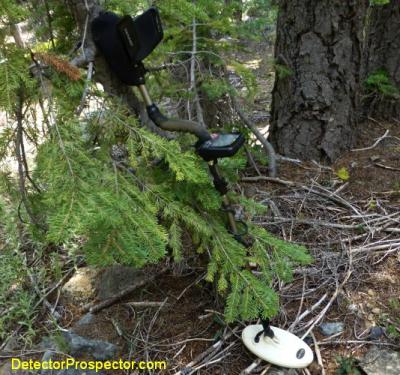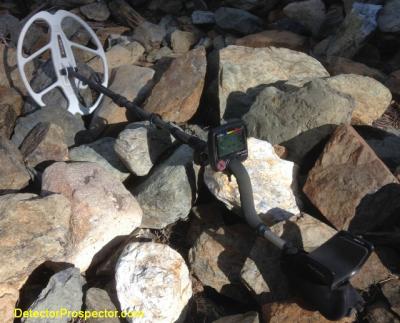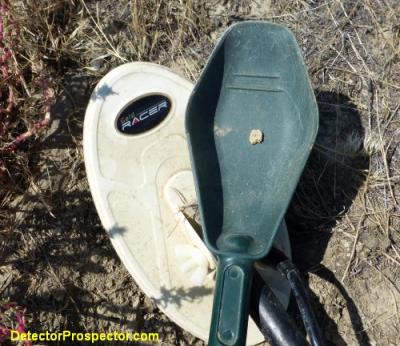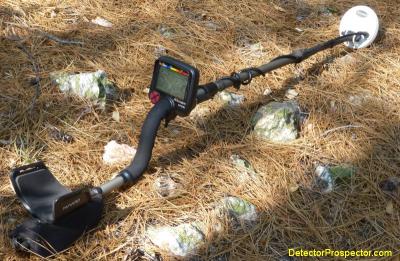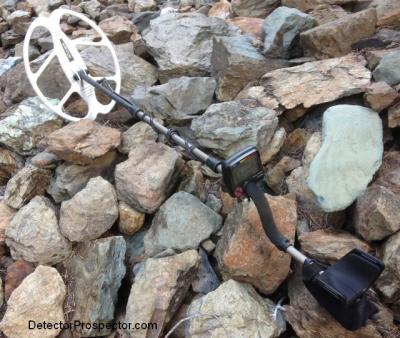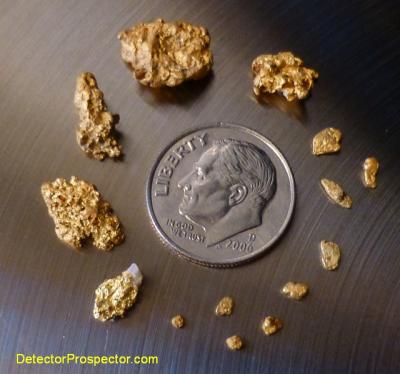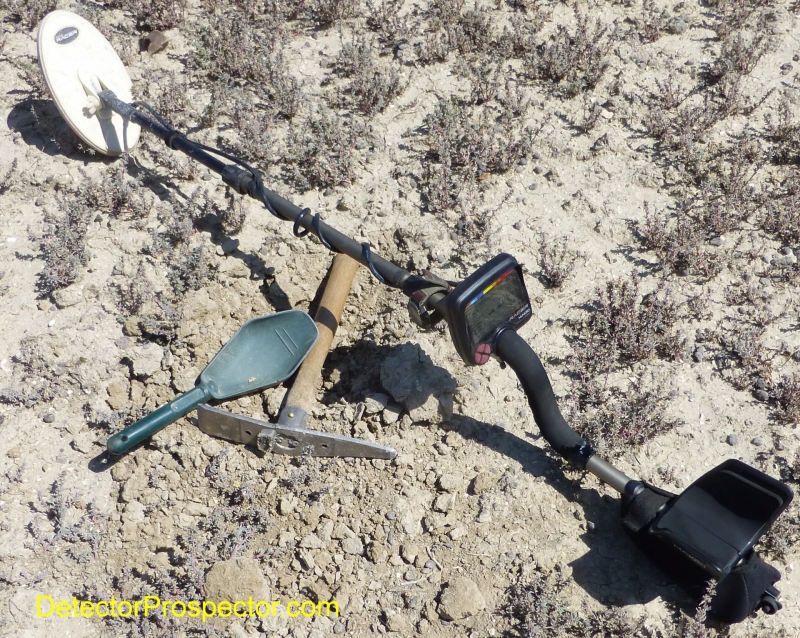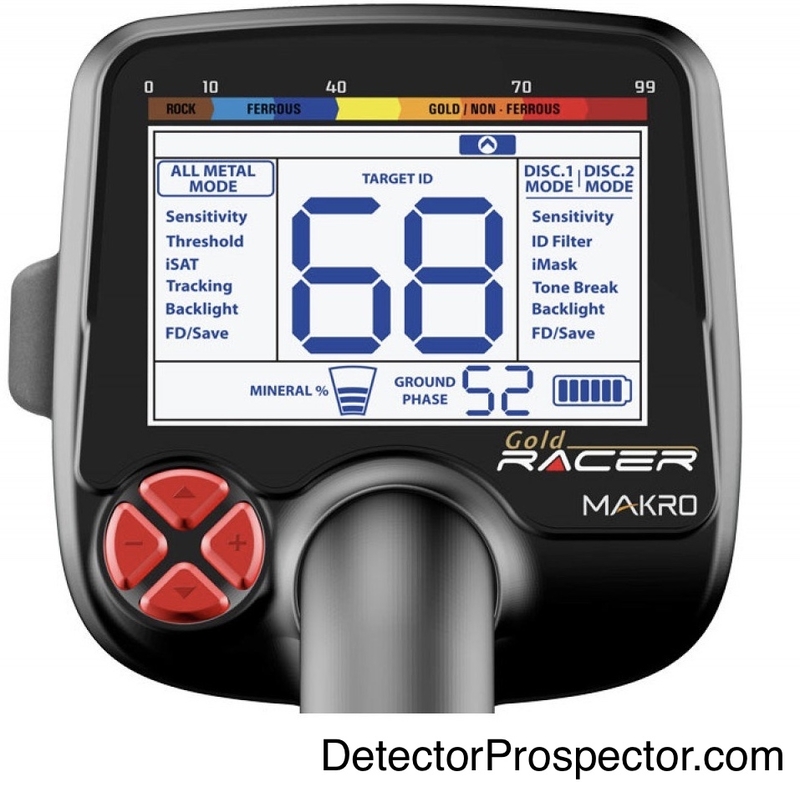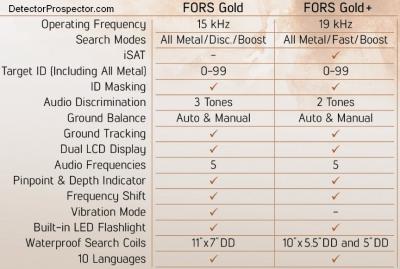-
Posts
19,762 -
Joined
Content Type
Forums
Detector Prospector Home
Detector Database
Downloads
Everything posted by Steve Herschbach
-
Simple really. The coil cable has metal in it. Any loose cable moving around a foot over the coil can cause a false signal. In general the cable should go straight up the shaft, with excess wound at the top near the control box. However, in order to allow the coil to swivel and change angles, it is common to leave a little slack near the coil. It the coil strikes something hard enough, that short bit of cable can shift quickly, causing a transient false signal. The fitting at where the coil connects to the control box not being absolutely firm can do the same thing.
-
As I said, I am only assuming looking at the FORS Gold+ in front of me that the coil on the production Gold Racer will look the same, but I do not know that for a fact and Dilek will have to confirm. Perhaps I should not have mentioned it yet, cart ahead of the horse and all that. All details on accessories and pricing I will have to leave to Dilek.
-
Can't beat the Bug for simplicity. I never understood people who think it is hard to run. The Gold Racer to really leverage what it offers will take some learning. The all metal mode is just as straight forward as any. The disc modes is where things get intriguing. I am just not seeing any dire need for a happy owner of a GB2 to ditch it in favor of the GR per se. There are other GB2 owners, who, like me, will look at the Gold Racer and tell themselves "I gotta have that one instead" but they will know who they are and why and don't need me to tell them so.
-
Ray, I am just staying out of all that and leaving it to wiser and more experienced hands. The high frequency can cut both ways. It seems to call big ferrous as ferrous better than lower frequency machines for some reason, but the machine is so sparky it can produce transient high tone blips in ferrous. I am sticking with my "it's a gold machine" line until somebody else proves otherwise. It has a killer all metal mode that alone is enough to make me happy and in scattered ferrous seems really well behaved. But I did not dive into any nail pits so just don't know.
-
Small coil is epoxy filled. Both 10 x 5 coils are hollow. Initially that kind of turned me off as hollow coils knocking around kind of bug me. This is stupid but they sound funny bouncing off stuff. But after comparing to the Gold Bug Pro and even my F75 with the Fisher epoxy filled version, I realized just how heavy those coils are out there on the end of the stick. The Fisher being epoxy filled weighs in at 1 lb 2.6 oz whereas the Makro coil weighs 12.8 ounces. The Gold Racer is simply better balanced as a result and now that I have gotten used to them I am happy with the coils. I have experienced a false now and then with the Gold Racer but only on rare occasions, and I want to be sure and again note the coils have changed since I got my last prototype. I believe they will look more like what is one the new FORS Gold+, redesigned with beefed up ears and cable entry point. But you can't hold Makro to that as I have not been told that directly, just makes sense. Bottom line is I did not consider coil falsing to be an issue but it might happen now and then. Might be I did not have my cable wrapped tight enough so I am giving the benefit of the doubt until we see production units. I promise you I hate detectors that are coil sensitive and would tell you in a second if that was bothering me.
-
Seriously there are only two other options for me. It would be the Fisher Gold Bug 2 or the White's GMT. Both are excellent detectors used by thousands of people successfully. The one that really seems to get hit by the Gold Racer is the GMT. The Gold Racer simply packs a heck of a lot more on a lighter more compact package at what I suspect will be a lower price. I don't care about price myself, the Gold Racer basically is just in a configuration I prefer over the GMT. Gold Bug 2 with 6" coil? Probably still will end up when it shakes out as king of the crumb pile. The Gold Racer does give it a fair run for the money but I have not had a Gold Bug 2 at hand to do direct comparisons with. When I knew what was coming with the Gold Racer I sold my Gold Bug 2 immediately. For me in the case of the two it is more a features fight, and if all you need is something to hit tiny gold the Gold Bug 2 gets the job done. Heck, it may be at the end of the day that I just want a newer toy to play with and been there done that with the Gold Bug 2. Now if you toss the big coil in the mix it gets more interesting and the Gold Racer caught me off guard in that respect. You just can't get a big DD coil for a Gold Bug 2 and that alone right now is enough to have me packing the Gold Racer around instead. Guys, no sales pitch here. Stick with tried and true and proven unless you can afford to do the buy and try thing. Just too early yet in several ways to be doing serious head to head comparison/decision type stuff. All I can say is the GPZ and GR suit me for now.
-
Hi Merton, Until the final version hits the street I am not sure. What you are describing is what they have in the new FORS Gold+. On my prototype Disc2 just seems like Disc1 on steroids. I simply do not have enough experience with the DEUS to pick numbers but I am guessing nothing much different than what you are seeing on your standard Racer. Which answers the is this a general purpose machine for a one machine person? In my opinion, not particularly. If you want a general purpose machine I would get a general purpose mid-frequency detector. On normal size targets there is little difference between the Gold Racer and the standard Racer or the Nokta units. It is only as the targets get smaller that the gap appears. In a nutshell, this is a machine for people looking for tiny targets first, everything else secondary. That is not to say it won't find the larger gold, it will. I just don't think it will do so any better than the standard Racer. Again though, when the production models get in people's hands that view might change based on more people using the machine under more varied conditions, but I would not at this time recommend a person without a detector get the Gold Racer as a general purpose detector. Sit back and let it sort out. What is it? Well, mn90403 it is pretty simple for me. I right now use a GPZ 7000 for 98% of my nugget detecting. I do need a second machine however. For sniping tiny gold. For checking quartz specimens. For working trashy areas. If nothing else just in case the GPZ dies! I want something compact and light weight that I can just toss in the back of my truck with no worries, and always have handy if I need it. Cheap accessory coils, runs forever on four AA batteries. GPZ 7000 and Gold Racer it will be for me. All the other nugget machines are going away or already gone. What about this? There is a person out there that has no detector. They basically want a nugget detector, and desire what the GMT and Gold Bug 2 offer by way of small gold capability. Yet they do not want a 100% dedicated nugget machine, just in case they want to do a little coin detecting or something else. So maybe 90% nugget detecting and other stuff now and then, or so they think. That is a totally made up but reasonable scenario to me.
-
Frankly, that about wore me out! That review was for general consumption and will no doubt get posted around elsewhere. Exclusive to the members of this forum will be more technical details and blatant opinions on my part, but for now I need a break from the keyboard. More on this thread soon. In the meantime, post any question you may have and I will answer to the best of my ability - after the pizza!.
-

Makro Gold Racer 56 kHz - Coming Soon!
Steve Herschbach replied to Nokta Detectors's topic in Nokta / Makro Metal Detectors
OK, took all day! Here is is.... Detailed Review Of Makro Gold Racer By Steve Herschbach -
Makro Gold Racer and a small Nevada gold nugget it just detected The Makro Gold Racer has been one of my most anticipated new VLF metal detectors in years. This completely new model represents something I have wanted for a very long time – a high frequency VLF metal detector that does not skimp for features, in particular as regards discrimination options. A little background. First, I have been testing prototypes of the Makro Gold Racer, and this review is based on those prototypes. The final version due soon has a completely new LCD display layout, audio boost, refinements to other settings, and physical refinements like a change in the handle angle, etc. That being the case this review should be considered preliminary and final specifications are subject to change, as well as details you may see in my photos regarding the physical design of the detector. Second, what is the intended market for the Makro Gold Racer? The machine looks deceptively like many other detectors aimed at general purpose metal detecting. I want to emphasize that first and foremost this is a gold prospecting detector. There are only a few other detectors that directly compare to the Gold Racer which is running at a very high frequency of 56 kHz. Comparable detectors would be the White’s GMT at 48 kHz, the Minelab Eureka Gold running in its 60 kHz setting, and the Fisher Gold Bug 2 at 71 kHz. The intent with very high frequency detectors is to sharpen the response on extremely small metal targets. High frequency detectors are in a niche all their own when it comes to finding the tiniest of gold nuggets. This sensitivity does come at a cost however, in that the detectors are also responsive to ground mineralization and hot rocks that less sensitive, lower frequency detectors might ignore completely. There is no free lunch in detecting, and I want to caution anyone thinking that the Makro Gold Racer is going to be a magical solution to all their detecting desires to be realistic about things. Inevitably when new detectors come out people fall victim to wishful thinking, and I would like to try and avoid that here. When it comes to reviewing detectors I do the best I can to describe detectors to help people decide if they might be interested in them or not. Do realize again however that this review is based on preliminary information. Also, I honestly do not want people buying new metal detectors based solely on my reviews. There will be some of who want the latest and greatest right now, and I appreciate that, but being a first adopter does have its risks. My normal advice to people is to never buy anything based on a single review, but to wait for more of a consensus opinion to emerge. I have used the Gold Racer in the field, and I have found gold with it. Right now though if it is just a matter of you wanting to know if the Makro Gold Racer can find gold then I refer you to the excellent field review with photos posted by Ray Mills at the Detector Prospector Forum. In outward appearance the Makro Gold Racer resembles its immediate predecessor, the Makro Racer, but this really is a new detector, not just a Racer running at a higher frequency. Feedback on the original Racer has been incorporated as well as extensive testing and commentary from prospectors around the world. Besides the obvious color difference, major physical changes include completely redesigning the layout of the LCD display to better differentiate what are all metal functions and what are discrimination functions. All metal functions are on the left, and discrimination functions are on the right. I think the new display is more intuitive and better accommodates the extra functions implemented on the Gold Racer. The angle of the bend in the S rod handle grip has been relaxed based on feedback from Racer owners. The vibration mode was eliminated, shaving a tiny amount of weight and freeing up room on the display menu. The Gold Racer with stock 10” x 5.5” DD coil and NiMH batteries installed weighs in on my postal scales at exactly three pounds. Coils available at launch are the 10” x 5.5” DD that is stock on the detector. Optional coils include a 10” x 5.5” concentric coil, 5” round DD coil, and a light weight 15.5” x 13” DD coil. Makro Gold Racer with 5" round DD coil Let’s take a look at the functions. Under All Metal on the left side of the meter are the functions that apply only to the All Metal mode. On the right are the functions for the two Discrimination modes. The settings are independent in each mode, and once set can be saved when the detector is powered down. This simple and intuitive setup is also part of the power of the Makro Gold Racer. It is incredibly easy once each mode has been customized to flip quickly between the three modes, cross checking target responses to make a dig/no-dig decision. All Metal is the heart and soul of nugget detecting, and the Makro Gold Racer has an extremely powerful, smooth, and sensitive threshold based all metal mode. The Sensitivity setting is familiar to anyone who has used a metal detector, except that there are three base levels of sensitivity or gain. Significant boosts occur between 39 - 40 and again between 69 - 70. Most detectors max out at what is a setting of 69 on the Gold Racer. Settings of 70 and above are a type of hyper gain setting that takes the machine above and beyond, but in extreme ground overload signals may occur. Overload signals are indicated by a “warning siren” audio and the machine is telling you that there is either a large metal object under the coil, or that you are encountering extreme mineralization. In the case of mineralization, either raise the coil slightly while scanning, lower the sensitivity setting, or both. Overloads occurring at 70 will almost always be eliminated by dropping to 69. Rest assured very little is lost by lowering sensitivity to 69 or below, again, because many detectors cannot be set as hot as the Gold Racer even at their maximum setting. Do you ever run detectors and have the distinct feeling some performance has been left on the table, because the detector can always be run at maximum settings? Makro has given you that extra power for where it can be used, but in doing so they expect you will lower settings in places where that extra power works against you. Luckily, the audio alert makes it easy to know when this is. Most people do not know it but many detectors simply shut down and quit working under similar conditions with no indication at all to the operator, a situation referred to as “silent masking”. The threshold setting is the normal control that sets the volume of the slight audio tone that is key to any experienced nugget hunter finding the tiniest or deepest gold nuggets. The most minute variations in the threshold tone can indicate a gold nugget, and the ability to read the threshold is what sets most really good nugget hunters apart from everyone else. Makro has added a feature to the Gold Racer called iSAT, for “Intelligent Self Adjusting Threshold”. This setting consists of several levels of adjustment that vary the rate at which the threshold tone steadies itself. Higher levels of iSAT smooth the threshold more aggressively which aids in maintaining a smooth threshold in rapidly varying ground. Lower levels allow for faint variations to be heard more clearly in milder ground for extra depth and sensitivity. The Gold Racer can be ground balanced three ways. Holding the trigger switch under the control pod in the forward position activates an instant automatic ground balance. Just pump the coil over the ground a couple times, release the trigger, and you are done. There is a short delay when you release the trigger, and during this delay you may manually adjust the ground balance setting. The instant ground balance is neutral to slightly negative. Those that like a slightly positive ground balance need only perform the instant balance, then tap the right hand control button three of four times. The Tracking function on the control panel engages and disengages automatic ground tracking. This is most useful where the ground conditions vary wildly, a perfect example being mixed cobble piles or river bars. The tracking is very quick yet resists tracking out genuine gold signals as much as possible. This can also be an aid to anyone new to ground balancing detectors as it makes the process entirely automatic. The Backlight setting adjusts the illumination level of the backlit screen. The FD/Save setting allows adjustments to be saved when the detector is powered off, while the FD function resets Factory Defaults. There is also a Frequency Shift setting to help eliminate outside electrical interference from power lines, or another Gold Racer being operated nearby. This is set through a combination of control buttons but not visible on the menu. Finally, although this is a true threshold based all metal mode, the meter acts independently in discrimination mode at all times and indicates target id information when the signal strength is sufficient to do so. Makro Gold Racer - clear, bold display Under the Discrimination menu are settings that are completely separate from the All Metal settings and also saved or reset separately. Disc 1 is a standard two tone mode with low tone ferrous and higher tone non-ferrous. Disc 2 is a similar but deeper, more powerful mode. Quick switching between these two modes, each with fully independent settings, creates a many layered and subtle approach to target discrimination. Both discrimination modes are silent search, no threshold based systems. However, new to Makro models is the ability to set the point at which low tones flip, or “break” over into being higher tones. Typically 39 and lower target id will cause a low tone, and 40 and above a higher tone. This ability somewhat replaces the three tone mode on the original Racer because by increasing the Tone Break setting it is possible to create various coin detecting scenarios. For instance, all targets with an id number below copper penny could register low tone, and therefore copper pennies, dimes, quarters, and dollar coins a higher tone. Conversely, lowering the Tone Break setting would create a more conservative approach for nugget detecting by accepting a little more ferrous digging in return for possibly finding another nugget or two. The Sensitivity control on the Disc menu is the same as but independent of the All Metal setting of the same name. ID Filter is a variable discrimination control, with higher settings eliminating or blanking out id numbers lower than the current setting. This setting is independent for each Disc mode, and again flipping back and forth can create some interesting scenarios for comparing targets at completely different sensitivity and ID Filter levels. This quick mode switching between All Metal, Disc1, and Disc2, all with independent settings, is a very powerful tool once you get used to it. Also new with the Gold Racer is the iMask setting. I noted at the start of this review that all metal detector designs involve making trades of some sort. Extreme high frequency sensitivity to small metal targets does increase chatty false responses in extreme ground when in the discrimination modes. iMask attenuates or suppresses weaker target responses in the discrimination modes and provides a secondary level of adjustment separate from and in addition to the Sensitivity and ID Filter settings. If the detector is producing lots of quick, spurious signals in the discrimination modes, reducing sensitivity or increasing ID Filter settings or both is the first line of attack. If this does not work, go back to the original settings on those functions, and try increasing the iMask setting. If this does not work, again lower sensitivity or increase the ID Filter or both on top of the current iMask setting. iMask acts as a pre-filter giving an extra level of control to help deal with extremely bad ground conditions. Finally, Disc1 is a less aggressive mode than Disc2, so using Disc1 offers even another level of possible options when dealing with bad ground in the discrimination modes. The Backlight setting is independent for the discrimination modes, as is the Factory Default/Save Settings function. I think it goes without saying that there has never been a high frequency metal detector ever produced with this level of options and control. There are a lot of variables to play with here, and I would not be truthful at all if I said I have this machine all figured out. In fact, I think part of the fun with the Makro Gold Racer is we are entering uncharted territory. Until the final version of the machine is released, and until quite a few people get their hands on it and experiment, it is very difficult to say just what applications creative detectorists may find for the Gold Racer. It is a very powerful VLF gold prospecting detector, I can vouch for that. Applications also may be found for jewelry detecting and relic hunting in particular, and even coin detecting, due to the unique combination of features the Makro Gold Racer offers. OK, finally – some notes on real world use! Again, this is all based on prototype models and so I can only speak in generalities for this report. However, there is no doubt in my mind that even the prototype detectors rival anything currently available in a VLF detector for finding tiny gold nuggets. I can easily locate flakes of gold weighing under one tenth grain with the Gold Racer and the stock 10” x 5.5” DD coil. In fact, the machine is so hot with the stock coil I thought using a smaller coil offered minimal if any benefit, mostly because of lost ground coverage and possibly lost depth on larger nuggets. I would only use the smaller coil myself for nooks and crannies where the stock coil can’t fit, but otherwise the stock coil really is the way to go in my opinion. Keep in mind I did say grain not gram. There are 480 grains per Troy ounce and in my opinion I can find flakes all day long with the Gold Racer that weigh less than 1/10th grain, or less than 1/4800th ounce. Smallest nugget unweighable, largest 2.4 grams In trashy locations I generally preferred running in all metal and just checking the meter for ferrous targets, which tend to lock in hard at 21 or 22 on the numbers. In theory anything under 40 is ferrous, but to be safe I might investigate items as low as 35 or even 30 depending on the situation and amount of trash. However, as I noted most ferrous locks in hard around 20 leaving no doubt what the target is. In All Metal mode very tiny or very deep targets beyond discrimination range give no target id at all, automatically meaning they need investigation. The main reason I prefer to always hunt in All metal is the extra depth and sensitivity it affords, and checking targets visually is very quick and more efficient than toggling back and forth to a Disc mode under normal circumstances. For areas with too much trash where meter watching might get to be a bit too much, I normally use one of the disc modes set for two tone ferrous/non-ferrous. Iron targets just burp away, while non-ferrous target pop out with a beep. If even that got to be too much for some people, increasing the ID Filter to eliminate most ferrous responses completely can make for a quieter experience in really trashy locations. As always, I must include the warning that the more discrimination applied, the more risk of missing a good target. Use no more discrimination than needed to preserve your sanity! I used the Gold Racer to hunt a couple trashy areas where I just could not go with my big dollar all metal machine, and easily located nuggets in the midst of trash. For me personally the Makro Gold Racer fills in two areas where the high price big gun detectors come up short. The ability to find the tiniest, most dispersed gold possible, both in flake form or enclosed in specimen rock. And the ability to deal with really trashy areas where good discrimination is needed. Perhaps the biggest surprise for me was when I decided to give the 15.5” x 13” DD coil a try. Honestly, I did not expect much from it. You normally do not see a coil this large for high frequency machines because the ground feedback usually overwhelms them, negating any gains that can be had regarding depth. Instead, the Gold Racer seemed to be even better behaved with the larger coil than with the smaller coils. I hunted some cobble piles with it and it ran smooth as can be at higher sensitivity levels. I then wandered into some moderately hot ground with it, still with no problems, and was actually surprised when I came up with a couple small gold nuggets with it. The first was only 0.8 grams which I thought was pretty fantastic. So I put a little more effort into it, and found a 0.3 gram nugget. With a 15.5” x 13” DD coil on a VLF? That is really kind of unheard of, and I was thoroughly impressed. I am not sure what is going on there but I do know the Makro detectors can sense what coil is on the detector. Something different going on with that big coil? I don’t know, but the results and performance surprised me. Also surprising was that for such a large coil it actually was not bad swinging it for half a day. That could be from my using large, heavy detectors all summer however. Still, it was an eye opener all around and changed how I think my Gold Racer might get used in the future. It looks to have more use for covering very large areas blue sky prospecting than I would have imagined. This coil with scuff cover weighs 1 lb 11 oz (766 grams) as weighed on my postal scales. Makro Gold Racer with GR40 15.5" x 13" coil I would be remiss if I did not include at least a note on the versatility possible with the Gold Racer. I recently took it to a local park. Now, my ground in Reno is screaming hot, full of magnetite. The mineral percentage graph on the Gold Racer and similar machines all come up one bar short of maxed, and ground balance numbers run around 88-90. A magnet dropped in this stuff comes up with a lump of magnetite. As a result getting accurate target id numbers with even the best coin detectors past 5” is a chore. I know that sounds crazy but it is the truth. I ran the 5” DD coil and even then had to back the sensitivity down to 69 to prevent overloads in the worst areas. One thing about the Racer detectors that I have heard people complain about, and that is that they tend to up average target numbers in bad soil. For me this is a good thing. Many detectors will see target id number average lower in bad ground, and so fringe targets are more likely to get identified as ferrous when they are in reality non-ferrous. This is obviously not a good thing for nugget detecting. The Racer and the Gold Racer both tend to up average, and so targets like lead sinkers or aluminum that you would expect to give lower numbers often give coin like responses with the Racers. It is odd to see in practice. I got a good high signal reading near 80 at about 5” that when dug up turned out to be a common round lead fishing sinker. Out of the hole the target id promptly dropped to about 45. This effect whether by design or by accident is common with European detectors. I think it is by design because first and foremost these machines are made to pull non-ferrous targets out of ferrous trash. Improperly identifying a non-ferrous item as ferrous is the worst possible result, and so up averaging helps insure that non-ferrous items will not be missed. However, it also means these types of detectors are not as efficient at cherry picking coins as common coin detectors are. You get the coins for sure, but you dig more trash doing it. Still, I experimented a few hours and if you are content to live with the limitation I just described you can actually make some good finds with the Gold Racer under almost any conditions. The ID Filter works very well, and by just running it all the way to 79 it was easy for me to cherry pick a few coins though larger aluminum items like screw caps or big pull tabs often came up in the 80s also. I do think this is a result dependent on ground conditions to some degree, but really the Gold Racer is best suited for people like me who want to recover all non-ferrous targets. I prefer to hunt jewelry rather than coins myself, as one gold ring makes up for a pile of coins. And to hunt jewelry you have to dig aluminum, no two ways about that. The Gold Racer will suit me well hunting jewelry, especially micro jewelry like ear rings and fine chains. This report is very long, and yet I really am just skimming over the features and possibilities inherent in the Makro Gold Racer. I will close by once again noting that while everything regarding the Gold Racer is pretty much set in stone at this point, last second changes are possible. Look for more soon when the factory production models hit the street. I also get frustrated when people want information on new units, but then turn right around and characterize reports trying to provide that information as hype or a sales pitch. I have tried my best here to just present what facts I can without leading anyone to think that the Gold Racer is anything other than what it is. And that, in my opinion, is a very interesting, unique, and capable metal detector. I look forward to hearing for myself in the future what people think about it and the applications and tricks they come up with, because you pretty much need to toss anything you think you know out the door when approaching this machine. Many thanks to the folks at Makro and in particular Dilek Gonulay for providing me with the opportunity to be one of the first to use the Gold Racer. I admit that VLF detectors were beginning to bore me, and the Gold Racer has reignited my interest in seeing what they can do for me. Specifications and details on the Makro Gold Racer Disclosure Statement
-
I can tell you this right now. If you are trying to detect the smallest gold no VLF running under 40 kHz is as hot as the Gold Racer. The question is more like, which would you rather have, a Gold Bug 2, a GMT, or a Gold Racer? Until we find out what it sells for however a critical part of the question cannot be answered.
-

Detecting Along Gold Mint Trail
Steve Herschbach replied to Robert F's topic in Detector Prospector Forum
Very hot bedrock in there, difficult to run a VLF. And gold, if you are lucky enough to get over any, is small. It would be a good place for a Minelab SDC 2300 but not very good odds of finding gold. Lots of loose rock and boulders, not so much in the way of detectable ground. I have found gold in Hatcher Pass with a Gold Bug 2, but the ground was so hot I just eyeballed quartz specimens, and ran them under the coil by hand. http://www.detectorprospector.com/steves-mining-journal/metal-detecting-lode-gold-hatcher-pass-alaska.htm Gold Ore From Hatcher Pass Found With Gold Bug 2 -

Makro Gold Racer 56 kHz - Coming Soon!
Steve Herschbach replied to Nokta Detectors's topic in Nokta / Makro Metal Detectors
Tomorrow, I promise. I wanted to get some time in park detecting with it today. -
I will try to answer that question in future posts in the next few days. Suffice it to say that even with detectors in hand trying to get a clear winner when faced with a pile of 14 - 19 kHz detectors can be an exercise in frustration. Luckily the Gold Racer at 56 kHz is an easier call. Just remember - there are always trade-offs when designing metal detectors. It is not just a matter of saying "this one is best" and tossing the rest. I really, really wish it were that easy. It comes down to what you want the machine to do most and what you are willing to give up to get that.
-

Fors Gold Plus Maiden Voyage
Steve Herschbach replied to californiagold's topic in Nokta / Makro Metal Detectors
Here is a chart - more details at http://www.detectorprospector.com/gold-prospecting-equipment/nokta-fors-gold-plus-metal-detector.htm FORS Gold at 15 khz and with three tone "coin mode" is more multi-purpose in intent, the FORS Gold+ at 19 kHz and modes tweaked for nugget hunting is more gold specific although relic hunters will also like it. Internet pricing FORS Gold $595 and FORS Gold+ $679(includes two coils) -

My Video Rundown Of The FORS Gold Plus
Steve Herschbach replied to Keith Southern's topic in Nokta / Makro Metal Detectors
Great introduction Keith, I will reference it when I get around to making some commentary. Any gold guys want to see the air tests on some gold nuggets that is around the 33 minute mark. -
Actually amazing at this point, given that Chicago is aware. Did you ever talk to the head of customer service who called you?
-
Well, it really is all about just knowing your machine well and putting yourself in good locations. Lots of hours helps. We all love talking about detectors and the never ending quest for the perfect machine. Just give me any decent detector, however, and I could post plenty of finds. If all I had was, for instance, a basic $499 Gold Bug, not even the Pro, and I could go find gold nuggets, coins, jewelry, etc well everywhere but in salt water. If I had just a CTX I would come out better in salt water and give up some in the nugget dept but I still could go find gold nuggets with it. It really is not rocket science. Detectors that get used find stuff, detectors in closets gather dust.
-
Wow, no need for me to post anything Ray - you have been killing it with the Gold Racer! Great post, great results, great photos! And no worries on photos, l like them big and the forum handles them well. I have plenty of bandwidth. Specifications and Details on the Makro Gold Racer and Detailed Review Of Makro Gold Racer By Steve Herschbach
-
Great post Monte, and very much in line with my way of thinking. My focus of course is nugget detecting, but I do enjoy using detectors to do anything. That is good because no mater where I find myself there is always a reason to go metal detecting. I have followed many forums over the years, and it is just like reading movie reviews. Some reviewers hate movies I like, other reviewers and I think alike. So I pay attention to the reviewers that like the same movies I like. All it is of course is different people liking different things, and nothing wrong with that. A long time ago I started paying attention to you in particular and have read a lot of your posts over the years. A lot of what I may spout now I learned from you. In a nutshell the minimal discrimination pull non-ferrous out of ferrous techniques, and of course the now famous Monte Nail Board Test https://www.ahrps.org/_tipsAndTechniques/Nail_Board_Performance_Test.pdf Anyway, I have never met you but I do owe you, and so thank you very much for sharing your time and knowledge with all of us. You and I share another similar trait - our posts can get out of control and go on for some time. We just love talking detectors and once we get going sometimes it is hard to stop! The T2 I feel is the bang for the buck unit but I favor the F75 because I can employ concentric coils on it plus a few niceties like saving settings when shut off, backlight and such. But the T2 has superior iron resolution almost identical to the Nokta/Makro machines. Unfortunately the T2 also shares the F75 tendency to identify certain non-ferrous targets as ferrous. As a result I use the F75 more for cherry picking and the Nokta/Makro for hardcore, don't mind digging a little more trash detecting. Oh well, nothing is perfect, every detector has flaws. But we keep getting closer to machines that are almost perfect and really it is all the extra competition putting the heat on that will get us there. Thanks again for joining the forum!
-

Fors Gold Plus Maiden Voyage
Steve Herschbach replied to californiagold's topic in Nokta / Makro Metal Detectors
Manzanita bushes Tom, not trees. Video from Keith Southern -
Nothing dramatic, just taking a longer term methodical perspective towards cleaning out small areas instead of wandering aimlessly around, going back to the same places over and over yet never feeling like I could say I covered it all. Now I look at a patch or park and have a loose plan for taking it apart in small mapped areas, one at a time, either removing all targets, or all non-ferrous targets, depending. The GPS integrated into the GPZ has upped my game considerably prospecting. For parks I just draw lines between landmarks like trees and corners and work it out piece by piece. But with parks I spread it around over time so as to not impact any one area too much at one time. I like to remain invisible. I am not the only person that does this. Every once in awhile I run into a place in town where I can't find a bit of aluminum. Aluminum is kind of like an indicator mineral. If aluminum exists I can still make good finds. If there is no aluminum, somebody doing what I am doing beat me to it. Nugget hunting I am hitting areas with sparse scattered gold. Most people would quit them for lack of finds. It is partly because I am new to the area and don't have much access to super great spots, so I am content to hunt areas everyone else has given up on. I am kind of like the cleanup crew coming in and gathering up the last bits. I make up for sparcity of finds by just putting in long hours.

